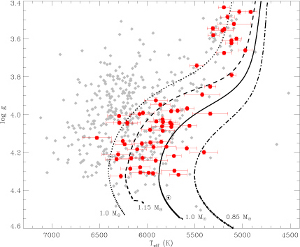|
|  |
Our galaxy is comprised of stars of different sizes, ages, and
chemical compositions. Current observational techniques can put some
constraints on stellar properties, such as effective temperature,
surface gravity and composition. However, in order to estimate masses
and radii, these measurements need to be complemented with theoretical
calculations of stellar evolution, where large uncertainties remain
due to our limited understanding of the physical processes taking
place in stellar interiors. This has implications in many fields of
astrophysics, from characterizing simple stellar populations in
galactic globular clusters to reconstructing the formation history of
distant galaxies.
Fortunately, stars like the Sun are not static and provide us with
additional information by means of their oscillations. Just like air
flowing through a musical instrument, vigorous convective motions in
the outer layers of stars excite acoustic waves that propagate through
the stellar interior. Depending on the characteristics of its resonant
cavity, the star will vibrate in different frequencies and overtones,
periodically swelling and contracting as the pressure waves travel
through its interior. Asteroseismology is the field of astrophysics
occupied with the study of these (and other) types of stellar
pulsation.
In principle, every star with a convective outer layer should present
acoustic oscillations, often termed solar-like oscillations as they
were first observed in the Sun. However, the brightness variations
they produce are fairly small, and can be on the order of only a
micro-magnitude. This level of precision is very challenging to obtain
from ground observations, which led astronomers to look for
possibilities of observing from space, where higher accuracy can be
achieved.
The Kepler mission has been the most successful example of
asteroseismic observations. As the illustration in Figure 1 shows, one
of the main aims of this satellite is to detect extrasolar planets by
the ”transit method“. As the planet on its orbit moves
between the parent star and the observer it will lead to a small
dimming of the star. The detected spectra of oscillations need to be
carefully analysed to distinguish between an external cause such as a
planet and intrinsic oscillations of the star itself. Staring at the
same field in the sky for the entire mission, Kepler continuously and
simultaneously monitors the brightness of more than 100,000 stars in
our galaxy.
One of the many important achievements of the Kepler mission is the
detection of oscillations in more than 500 stars in the so called
main-sequence phase. In this longest evolutionary phase in a star's
lifetime, stellar energy is produced by fusion of hydrogen - their
main constituent - into helium.
Using a measure of the stellar surface temperature (known as effective
temperature), we can compare in Figure 2 the seismic observations
— measured with an unprecedented level of precision - with
theoretical predictions. Interestingly enough, it turns out that a
large fraction of the seismic observations lie in the region where
evolutionary tracks for stars with masses close to one solar mass are
located. Is it possible to pinpoint the masses and radii of these
stars?
Asteroseismology provides the answer by what is known as the
”direct method“ for mass and radius determination. The two
global asteroseismic quantities, the large frequency separation and
the frequency of maximum oscillation power, are tightly correlated
over a wide range of values. Moreover, they are correlated with the
accurately known solar parameters, such as the surface temperature,
through scaling relations. As the oscillations depend on the
characteristics of the resonant cavity (i.e. the size of the star), we
can directly determine the mass and radius of a star using the global
seismic parameters coupled with the effective temperature.
Figure 3 shows more than 70 targets with a mass determined to be close
to solar among the large ensemble of stars with oscillations
detected. For a few of these stars, accurate metallicities (i.e. the
abundance of elements heavier than hydrogen and helium) have been
measured from spectroscopy, and the agreement with evolutionary
calculations is exquisite. The data therefore suggests that we have
successfully identified, for the first time, an evolutionary sequence
of field stars with masses very close to one solar mass.
These findings have several interesting implications for
astrophysics. We can now perform differential analysis on stars with
similar masses but in different evolutionary stages, following their
development throughout the main-sequence phase. It also demonstrates
the capability of asteroseismology to characterize stellar populations
in a certain region of the sky.
Seismic observations coupled with effective temperature estimates
allow the determination of masses and radii to a very high level of
precision for stars in different evolutionary phases. This opens the
exciting possibility of deriving stellar ages to a precision exceeding
that possible by other techniques adopted in stellar population
studies, such as isochrones or chromospheric activity
dating. Combining these results with parameters obtained from stellar
colours, such as metallicities, and angular diameter (and thus
distances when comparing this with radii) could offer a complete
picture of the stellar population in the Kepler field.
The possibilities are many, and the potential of asteroseismology to
constrain theoretical models, unveil underlying physical processes,
and discover the dynamical history of our galaxy is finally being
exploited.
V. Silva Aguirre, L. Casagrande, R. Schönrich, A. Weiss
Publication
V. Silva Aguirre, W. J. Chaplin, J. Ballot, S. Basu, T. R. Bedding, et al.,
"Constructing a One-solar-mass Evolutionary Sequence Using Asteroseismic Data from Kepler",
2011, The Astrophysical Journal, 740, L2
 http://iopscience.iop.org/2041-8205/740/1/L2 http://iopscience.iop.org/2041-8205/740/1/L2
|




